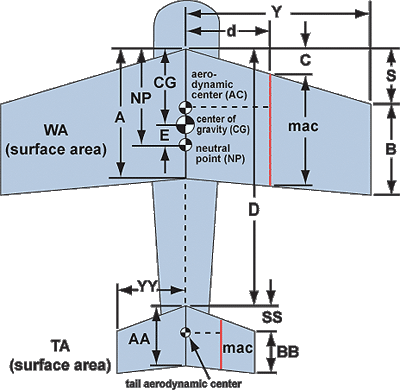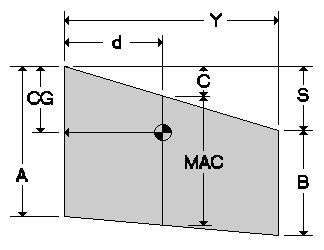

Moment is also referred to as the tendency of an object to rotate or pivot about a point (the zero point of the datum, in this case). Moment The moment is the moment of force, or torque, that results from an object's weight acting through an arc that is centered on the zero point of the reference datum distance. The algebraic sign is minus (−) if measured forward of the datum or the left side of the center line when considering a lateral calculation.
#Calculate mac for center of gravity plus#
The algebraic sign is plus (+) if measured aft of the datum or to the right side of the center line when considering a lateral calculation. Arm The arm is the horizontal distance from the reference datum to the center of gravity (CG) of an item. The lateral reference datum is usually located at the center of the helicopter.

This is to keep all the computed values positive. While the horizontal reference datum can be anywhere the manufacturer chooses, most small training helicopters have the horizontal reference datum 100 inches forward of the main rotor shaft centerline. For helicopters, it may be located at the rotor mast, the nose of the helicopter, or even at a point in space ahead of the helicopter.

There is no fixed rule for its location, and it may be located forward of the nose of the aircraft. The horizontal reference datum is an imaginary vertical plane or point, placed along the longitudinal axis of the aircraft, from which all horizontal distances are measured for weight and balance purposes. The location of the reference datum is established by the manufacturer and is defined in the aircraft flight manual. Reference Datum The reference datum is a reference plane that allows accurate, and uniform, measurements to any point on the aircraft. The center of gravity may change over the duration of the flight as the aircraft's weight changes due to fuel burn or by passengers moving forward or aft in the cabin. Different maximum weights may be defined for different situations for example, large aircraft may have maximum landing weights that are lower than maximum take-off weights (because some weight is expected to be lost as fuel is burned during the flight). Weight and Balance When the weight of the aircraft is at or below the allowable limit(s) for its configuration (parked, ground movement, take-off, landing, etc.) and its center of gravity is within the allowable range, and both will remain so for the duration of the flight, the aircraft is said to be within weight and balance. The area between the limits is called the CG range of the aircraft. The CG limits are indicated in the airplane flight manual. Center-of-Gravity Limits Center of gravity (CG) limits are specified longitudinal (forward and aft) and/or lateral (left and right) limits within which the aircraft's center of gravity must be located during flight. The nose baggage compartment of a Fokker F.XII in 1933, avoiding the problem of heavy weights towards the rear Ballast Ballast is removable or permanently installed weight in an aircraft used to bring the center of gravity into the allowable range.


 0 kommentar(er)
0 kommentar(er)
